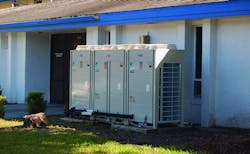VRV Gives All Contractors a Chance
For our 2018 series on Variable Refrigerant Flow/Variable Refrigerant Volume systems, we asked executives from some of the leading VRF manufacturers to describe when ductless is the best choice for a commercial building. These are the responses of Chris Bellshaw, vice president, VRV Product and Applications at Daikin North America.
Q: Chris, for contractors who now install both types, how would you advise them to go about making the proper assessment of which type to install?
Chris Bellshaw: “The important thing to remember with VRV/VRF technology is to look at what the system really is and how it is positioned in the market. A VRV/VRF system is basically a heat pump chiller that circulates refrigerant instead of water around the building to zoned fan coils. Therefore, anytime a VRV/VRF system is considered as a solution, it is generally a feature and function upgrade to an alternative solution.
“The benefit of a VRV/VRF system is that it allows contractors, who do not chillers or rooftop units (RTUs) with variable air volume (VAV), the opportunity to bid on projects that they would typically pass on. Smaller contractors, who are skilled at installing VRV/VRF systems, are able to provide the same benefits with in a simple, modular, direct expansion VRV/VRF system as compared to a larger, more elaborate chiller system. VRV/VRF systems allow seasoned contractors an opportunity to compete with simplified solutions."
“When an experienced contractor approaches a building, they are looking to provide solutions and value for their customers, while differentiating themselves from others in the market place. VRV/VRF systems allow seasoned contractors an opportunity to compete with simplified solutions. To do this, first you need to understand what the customer needs truly are, to assure the correct solution can be provided. One of the advantages of Daikin is that Daikin manufactures most solution types. Depending on the best solution, Daikin can respond with Daikin manufactured products ranging from single splits, RTU’s, VRV, all the way through to large tonnage air handling units (AHU’s) and chillers. This means that Daikin does not need to push any one equipment type. Instead, Daikin’s focus is on providing whatever equipment type that provides the best possible solution for the customer.
“When the needs of a project are known, you can take a step back and ask yourself, “How can I really make a difference on this job?” The contractor can truly evaluate the job by looking at the total cost of construction that provides the best value to the owner. This may mean working with other trades. For example, in an existing building, if it’s just replacement of a RTU due to life cycle or general upgrade and the customer has been relatively happy with the system, then 9 out of 10 times a replacement RTU is probably the most sensible and economical way to go. The sensible and economic decision may shift to a VRV/VRF solution in applications where there have been comfort, sound or controls issues, or a change in layout where different zoning is required. This is where the flexibility benefits of VRV/VRF systems may be a viable solution. A better solution for a school may be to use ducted or cassette VRV/VRF indoor units for the classroom, RTUs for the cafeteria or gymnasium and mini splits for the data closets.
“It’s also important not to label projects as VRV/VRF jobs or RTU jobs. There are many projects where a mixture of technologies can provide a better solution. A better solution for a school, for example, may be to use ducted or cassette VRV/VRF indoor units for the classroom, RTUs for the cafeteria or gymnasium and mini splits for the data closets. Forcing one type of equipment for a job can many times incur higher first costs as well as a less efficient system that may not provide the best economical long term solution.
“Another good example is our own Daikin Texas Technology Park (DTTP), in Waller, Tex., where we have Daikin RTUs for the large, open areas and for additional ventilation, VRV systems for the office area, conference and training rooms, and chillers with AHUs for manufacturing and logistics areas. The entire office area of DTTP is LEED Gold Certified. The complete facility spans over 4 million square feet – the size of 74 football fields.”

